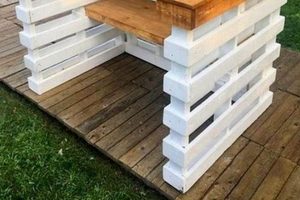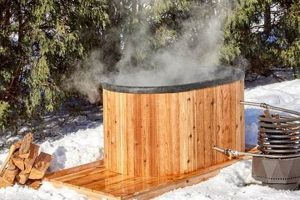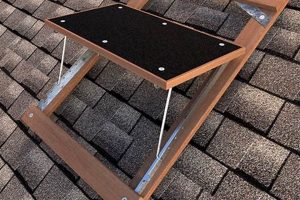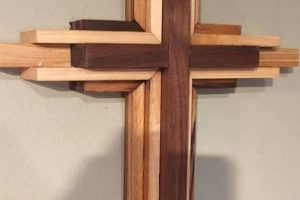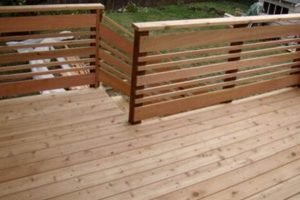Handcrafted wooden presents, constructed by the recipient or a third party, represent a thoughtful and personalized alternative to mass-produced items. Examples include custom-engraved cutting boards, hand-carved wooden toys, and individually designed wooden boxes.
The practice of creating personalized wooden items offers several advantages. It encourages creativity, provides a tangible connection between the giver and receiver, and often results in a unique and lasting keepsake. Historically, woodworking has been a valued skill, and gifting handmade wooden items reflects a tradition of craftsmanship and care.
The following sections will explore diverse types of these projects, relevant tools and techniques, safe handling practices, and considerations for selecting suitable wood types to ensure project longevity and aesthetic appeal.
Essential Considerations for Creating Personalized Wooden Presents
The successful construction of handcrafted wooden presents requires careful planning and execution. The following tips will assist in ensuring a high-quality, durable, and aesthetically pleasing finished product.
Tip 1: Material Selection: The choice of wood impacts the final products appearance and durability. Hardwoods, such as oak or maple, offer increased resistance to wear and tear, suitable for frequently used items. Softwoods, like pine or cedar, are easier to work with but are more prone to dents and scratches.
Tip 2: Accurate Measurement and Cutting: Precision is crucial for assembling wooden pieces. Employ accurate measuring tools and cutting techniques to ensure joints fit properly and the final product meets specified dimensions. A miter saw or table saw facilitates precise angle cuts.
Tip 3: Secure Joinery Techniques: Select appropriate joinery methods based on the project’s complexity and intended use. Dovetail joints and mortise-and-tenon joints offer superior strength and stability compared to simple butt joints, particularly for items that will bear weight or experience stress.
Tip 4: Proper Sanding and Finishing: A smooth surface enhances the final appearance and protects the wood. Sand progressively, starting with coarser grits and finishing with finer grits. Apply a protective finish, such as varnish, polyurethane, or oil, to seal the wood and prevent moisture damage.
Tip 5: Safe Workspace Practices: Woodworking involves tools that can pose risks. Always wear appropriate safety gear, including safety glasses and ear protection. Ensure adequate ventilation when working with paints, stains, and finishes.
Tip 6: Consider Personalization Options: Enhancing the wood item with custom engraving, paint, or wood-burning provides a personalized touch. Consider the recipients interests and preferences when selecting design elements.
Tip 7: Plan for Adequate Time: Rushing the process can lead to mistakes and compromised quality. Allocate sufficient time for each step, from planning and material preparation to assembly and finishing.
These guidelines promote safety and contribute to the creation of durable and appreciated wooden items. Careful consideration of these factors will result in a more refined and lasting gift.
The subsequent section addresses specific project ideas appropriate for various skill levels and occasions.
1. Wood Selection
Wood selection is a critical determinant in the quality, durability, and aesthetic appeal of handcrafted wooden presents. The choice of wood directly influences the longevity and intended use of the final product.
- Hardwood vs. Softwood Properties
Hardwoods, such as oak, maple, and walnut, offer superior density and resistance to wear, making them suitable for items intended for frequent use or those requiring high structural integrity. Softwoods, including pine, fir, and cedar, are easier to work with due to their lower density, but are more susceptible to dents and scratches. For example, a cutting board constructed from maple will withstand repeated use better than one made from pine.
- Grain Pattern and Aesthetic Considerations
The grain pattern of the wood significantly impacts the visual appeal of the finished item. Woods with intricate grain patterns, such as burl or curly maple, can add a unique aesthetic to wooden presents. The choice of grain should complement the intended design and style. For instance, a rustic-style wooden box might benefit from the natural imperfections and knots found in reclaimed wood, while a modern, minimalist design might call for a wood with a straight, uniform grain.
- Wood Stability and Moisture Content
The stability of wood, its resistance to warping or cracking due to changes in moisture content, is essential for long-lasting wooden presents. Kiln-dried wood, which has been carefully dried to a specific moisture content, is less likely to warp or crack compared to air-dried wood. Proper acclimatization of wood to the environment in which the finished item will reside is crucial. A wooden bowl crafted from improperly dried wood may develop cracks over time, compromising its structural integrity and aesthetic value.
- Ethical and Sustainable Sourcing
Selecting wood from sustainable sources reflects a commitment to environmental responsibility. Certified sustainable wood, such as that from the Forest Stewardship Council (FSC), ensures that the wood has been harvested in an environmentally and socially responsible manner. Utilizing reclaimed or salvaged wood reduces demand for newly harvested timber. When creating a wooden present, sourcing materials responsibly contributes to the value of the gift.
These considerations collectively determine the suitability of wood for crafting personalized wooden items. Careful evaluation of these factors ensures that the selection contributes to the longevity, aesthetics, and overall value of the final product. The subsequent step involves employing appropriate joinery techniques.
2. Joinery Techniques
Effective joinery techniques are paramount to the structural integrity and aesthetic quality of handcrafted wooden presents. The selection of an appropriate joinery method dictates the strength, durability, and visual appeal of the finished item.
- Butt Joints and Their Limitations
Butt joints, the simplest form of wood joinery, involve abutting two pieces of wood together and securing them with fasteners like screws or nails. While easy to execute, butt joints lack inherent strength and are generally unsuitable for projects requiring significant load-bearing capacity. For instance, a butt joint would be inadequate for constructing the legs of a small wooden table intended as a gift, as it would be prone to failure under weight.
- Dovetail Joints for Enhanced Strength
Dovetail joints, characterized by interlocking wedge-shaped projections, provide exceptional tensile strength and resistance to pulling forces. This technique is commonly employed in constructing drawers, boxes, and other items requiring robust connections. Hand-cut dovetails, while challenging to execute, demonstrate a high level of craftsmanship and significantly enhance the perceived value of the wooden present.
- Mortise and Tenon Joints for Structural Integrity
Mortise and tenon joints involve inserting a projecting tenon into a corresponding mortise (hole) in another piece of wood. This joint provides superior strength and stability, making it ideal for constructing frames, tables, and other structural components. Variations of the mortise and tenon joint, such as the through-tenon or blind-tenon, offer different aesthetic and functional characteristics. A mortise and tenon joint would be suitable for creating a sturdy frame for a personalized wooden picture.
- Pocket Hole Joinery for Concealed Fastening
Pocket hole joinery involves drilling angled holes into one piece of wood and then joining it to another with specialized screws. This technique allows for concealed fastening, resulting in a clean, aesthetically pleasing appearance. Pocket hole joinery is suitable for assembling face frames, tabletops, and other components where a visible fastener would be undesirable. For example, it can be employed to create a seamless connection between the top and sides of a wooden storage box.
The strategic application of these and other joinery methods directly influences the durability and perceived value of crafted wooden presents. Selecting the correct joinery technique not only ensures structural integrity but also contributes significantly to the overall aesthetic appeal of the finished item.
3. Finishing Options
The selection and application of appropriate finishing options are pivotal in determining the longevity, aesthetics, and tactile quality of handcrafted wooden presents. The finish acts as a protective barrier, safeguarding the wood from environmental factors such as moisture, ultraviolet radiation, and physical abrasion. The choice of finish influences not only the appearance but also the maintenance requirements of the item.
Consider, for example, a wooden toy intended as a gift for a young child. A non-toxic, durable finish, such as a water-based polyurethane, is essential to protect the wood from wear and tear and to ensure the child’s safety. Conversely, a wooden cutting board, another potential handcrafted gift, necessitates a food-safe finish, such as mineral oil or beeswax, to prevent contamination. The selection process requires careful consideration of the intended use of the gift and the properties of different finishing materials. The application technique also matters; an improperly applied finish can result in uneven coverage, streaks, or bubbles, detracting from the final appearance. Therefore, adherence to recommended application procedures, including proper surface preparation and drying times, is crucial.
In summary, finishing options represent an integral step in the creation of personalized wooden gifts. A well-chosen and expertly applied finish not only enhances the aesthetic appeal of the item but also contributes significantly to its durability and functionality. The failure to select and apply the correct finish can diminish the value and longevity of the gift, potentially rendering it unsuitable for its intended purpose. Therefore, understanding the properties of various finishes and their appropriate applications is essential for successful project completion.
4. Personalization Methods
Personalization fundamentally transforms a generic wooden item into a bespoke creation, reflecting the unique connection between giver and recipient. Integrating individualized elements elevates the significance of the gift, imbuing it with sentimental value and transforming it into a lasting keepsake.
- Engraving and Carving
The application of engraved text or carved designs personalizes wood through subtractive techniques. Names, dates, or meaningful quotes can be permanently etched onto the surface, commemorating significant events or relationships. Carved motifs, whether representational or abstract, add a tactile and visual dimension, transforming a simple object into a work of art. Consider, for instance, a wooden picture frame engraved with the names of the recipients and the date of their wedding, adding a layer of personal significance absent from a store-bought alternative.
- Painting and Staining
The strategic use of paint or stain introduces color and visual texture, aligning the wooden item with the recipient’s aesthetic preferences. Hand-painted designs, personalized color palettes, or the application of intricate patterns can transform a plain wooden surface into a vibrant expression of individuality. For example, a wooden toy chest painted with the recipient child’s favorite cartoon characters becomes a unique and cherished possession.
- Wood Burning (Pyrography)
Pyrography, or wood burning, utilizes a heated tool to create designs and patterns on the wood surface. This technique allows for the creation of intricate details and subtle shading, adding a rustic and artisanal quality. Personalized wooden signs, decorative plaques, or even intricate portraits can be achieved through pyrography, adding a unique and handcrafted touch.
- Embedded Objects and Mixed Media
Inclusion of embedded objects or integration of mixed media elements provides a tactile and visually diverse personalization approach. Seashells, stones, or metal inlays add depth and texture, reflecting the recipient’s interests or experiences. For example, a wooden keepsake box inlaid with small gemstones representing the recipient’s birthstones elevates a standard item to a treasured heirloom. The strategic use of mixed media transforms a simple wooden item into a complex and personalized work of art.
These diverse personalization methods extend the possibilities of creating individual wooden presents. Strategic application of these techniques elevates handcrafted items beyond their utilitarian function, transforming them into meaningful representations of personal connection and thoughtful consideration.
5. Project Complexity
Project complexity directly influences the success and satisfaction derived from creating individualized wooden presents. A project’s intricacy, determined by the required skill level, time investment, and specialized tools, serves as a critical factor in determining its suitability for a given individual. Overestimating personal capabilities can lead to frustration, project abandonment, and a substandard finished product. Conversely, selecting a project that is too simplistic may fail to provide a sense of accomplishment or fully explore creative potential. For example, a novice woodworker attempting to construct a complex piece of furniture with intricate joinery might encounter significant challenges, whereas creating a simple wooden box with basic butt joints would be a more manageable starting point. The alignment of project complexity with individual skill and resource availability represents a fundamental consideration for a positive crafting experience.
The practical significance of understanding project complexity extends beyond personal satisfaction. Careful assessment allows for efficient allocation of time and resources, minimizing material waste and maximizing the likelihood of producing a high-quality gift. A detailed plan, factoring in the necessary tools, materials, and construction steps, mitigates potential problems and ensures a smoother workflow. For instance, accurately assessing the time required to complete a project helps in managing commitments and avoiding last-minute rushes, contributing to a more relaxed and enjoyable crafting process. Understanding the interplay between different elements of project complexity enables informed decision-making and promotes efficient project management.
In summary, project complexity acts as a central determinant in the success and overall enjoyment of creating handcrafted wooden presents. Accurately gauging the demands of a given project and aligning it with personal capabilities are essential for achieving desired outcomes and avoiding common pitfalls. By carefully considering the various factors that contribute to complexity, individuals can embark on crafting endeavors with confidence, resulting in meaningful and lasting gifts. The challenges associated with misjudging project demands can be mitigated through careful planning, accurate assessment, and realistic expectations.
Frequently Asked Questions
The following section addresses common inquiries regarding the creation of personalized wooden items, offering guidance on material selection, techniques, and safety considerations.
Question 1: What are the most crucial safety precautions to observe when engaging in woodworking projects?
Adherence to stringent safety protocols is paramount when working with power tools. The consistent use of safety glasses, hearing protection, and dust masks is mandatory. Ensure that all power tools are equipped with appropriate safety guards and that all safety mechanisms are functioning correctly. It is imperative to disconnect power tools from the electrical supply before undertaking any adjustments or maintenance. Furthermore, maintaining a clean and well-lit workspace minimizes the risk of accidents.
Question 2: What wood species are most suitable for beginners undertaking woodworking projects?
Softwoods, such as pine and fir, generally represent the preferred choice for novice woodworkers. These species exhibit a softer texture and are easier to cut, sand, and shape compared to hardwoods. While hardwoods like oak and maple offer superior durability, they also demand greater skill and effort to manipulate effectively. However, it’s important to note that softwoods are more prone to dents and scratches, a factor to consider when selecting a material for high-use gifts.
Question 3: What types of finishes are safe for wooden items intended for food contact, such as cutting boards?
For wooden items that will come into direct contact with food, the use of non-toxic, food-safe finishes is essential. Mineral oil, beeswax, and certain types of shellac are commonly used options. These finishes create a protective barrier while remaining inert and posing no risk of contamination. It is crucial to avoid finishes that contain volatile organic compounds (VOCs) or other potentially harmful chemicals.
Question 4: What is the most effective method for preventing wood from warping or cracking?
To minimize the risk of warping or cracking, it is essential to utilize kiln-dried wood that has been properly acclimatized to the environment in which the finished item will reside. Kiln-drying reduces the moisture content of the wood, making it less susceptible to changes in humidity. Applying a protective finish, such as varnish or polyurethane, further seals the wood and prevents moisture penetration.
Question 5: What are the key differences between hand tools and power tools, and which are most appropriate for creating wooden gifts?
Hand tools, such as saws, chisels, and planes, offer greater control and precision, enabling the creation of intricate details and fine finishes. Power tools, including circular saws, routers, and sanders, provide speed and efficiency, making them suitable for larger-scale projects or repetitive tasks. The choice between hand tools and power tools depends on the complexity of the project, the level of precision required, and the individual’s skill level.
Question 6: What are some effective methods for personalizing wooden items?
Numerous techniques exist for personalizing wooden items, including engraving, wood burning (pyrography), painting, staining, and carving. Engraving involves etching designs or text onto the surface using specialized tools. Wood burning utilizes a heated tool to create patterns and images. Painting and staining add color and visual texture. Carving involves removing wood to create three-dimensional designs. The choice of personalization method depends on the desired aesthetic and the individual’s artistic skill.
These frequently asked questions provide foundational guidance for those embarking on the creation of DIY wooden items. Adhering to safety precautions, selecting appropriate materials, and employing suitable techniques contribute to the production of high-quality and personalized wooden gifts.
The following section will provide a concluding summary of the information discussed.
Conclusion
The preceding sections have explored the multifaceted aspects of crafting diy wood gifts, emphasizing the importance of material selection, joinery techniques, finishing options, personalization methods, and an understanding of project complexity. Successful execution requires careful planning, adherence to safety protocols, and a commitment to quality craftsmanship.
The creation of personalized wooden presents offers a tangible expression of care and creativity, resulting in items that transcend mere material value. Aspiring craftspeople are encouraged to approach these endeavors with thoughtful preparation and a dedication to honing their skills, thereby contributing to a legacy of handcrafted artistry.


